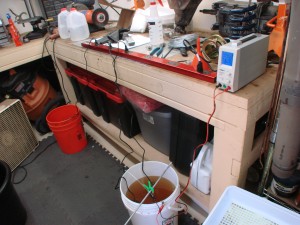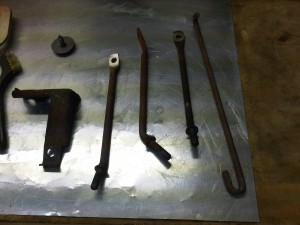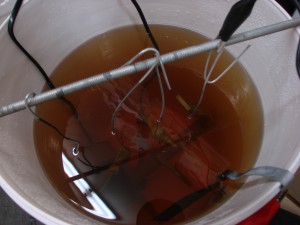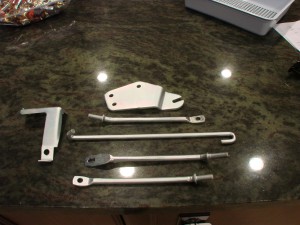John Purner and Complete Custom Wheel
Spoke with John Purner of Complete Custom Wheel today. Not quite ready to order anything yet but had a good chat with him about the project and bounced around some ideas. I ran CCW wheels on both my SM 240sx and on the SS Viper. While I haven’t received any sponsorship or special deals from CCW, I always look to them first. Their wheels offer a tremendous value in custom-sized forged wheels, part of why so many racers run them. I also think the “Classic” style they offer would look good on the Camaro-
/Classic/zoomed/1-1024.jpg)
John was having, as he put it, an “average” day. Well, I don’t know if I could have handled him on a good day – he had me laughing so hard I was practically falling out of my chair.
Turns out John and I share a lot of the same viewpoints on things related to these cars. It was refreshing to find someone else who not only thought like I do, but also felt so free to vocalize those thoughts without a Political Correctness filter. Doubly so, as he’s a guy who has a business selling parts to the public, oftentimes people in that position are so reserved in what they say to preserve their “image”.
I don’t know if I’ll be running CCWs on the Camaro. I don’t get anything if you decide to buy some. But you owe it to yourself to at least consider these wheels at the time of your next purchase, the guy is just that cool.
Caswell zinc plating and blue trivalent chromate
One enjoyable aspect of working on cars is taking something funky and making it nice and clean again. With plastic stuff that usually means throwing out the old and buying a new, but with metal, especially decent metal, there’s usually something you can do to “bring it back”, without having to buy a new part. Plus it’s fun to use as much of the original car as possible.
With the 240sx I had a lot of the suspension components powdercoated. Powdercoat is a much more durable finish than paint , available in a variety of colors and textures. Being a thick coating, it adds a little weight, and won’t work anywhere you have tight tolerances, like in a fastener or on two tightly mated surfaces. I plan to have several things on the Camaro powdercoated. RW Little is a place in San Diego I’ve gone to many times that has good prices and reliably quick turnaround.
Since building the 240 I’ve learned about how DIY’ers can apply other sorts of finishes to their metal parts at home. Another very popular coating in automotive applications is cadmium plating. This is often seen in brake boosters but also in some suspension components, on fuel pumps, or carburetors. The cadmium plating offers excellent corrosion resistance, and a neat yellow sheen when new.
Caswell plating has a range of kits to do all sorts of platings and coatings and anodizing at home. Standard cadmium plating involves some very toxic chemicals and is pretty much banned in CA. Caswell has a good alternative, their “Copy Cad” kit. With it, you apply a standard zinc coating, then dip the parts in a trivalent chromate, leaving the parts with a nice sheen. The most popular is the yellow chromate, which ends up leaving the parts looking just like a freshly cad plated part.
The plating kit arrived last Friday so I got to work-
For all of this, you need distilled water. Needed to go to Target anyway, so we loaded up the cart with 15 gallons.
There’s four buckets you need to do this-
One is a degreaser bucket, orange bucket in the pic below. The degreaser is supplied as a powder to get mixed with distilled water. Parts go in this after they’ve been prepped as a final cleanup stage. This stuff needs to be heated up over 110 to work its best.
Next is a rinse bucket. You use this to rinse the parts after degreasing, and any time you’re moving parts between the other buckets. Mostly you just hold parts over this bucket while spraying them with water to rinse between stages. You can see the edge of the black bucket there, my rinse bin/bucket.
After that they go in to the plating bucket, the white bucket with brown water in it. This bucket gets a bunch of a different powder, and some gnarly brown liquid mixed in. All this stuff is supposed to be pretty safe as far as plating operations go, but note the large box fan to the side. 🙂
The plating bucket gets heated also to about 140. It also gets an agitator pump to keep the fluid circulating within the bucket, which helps the plating process.
The last bucket and step (after another rinse) is the chromating process. Again, this stuff mixes with distilled water. Instead of the old-hat yellow, I opted to go with a blue chromate. It is a little bit less blingy, and a little bit less resistant to corrosion (not that the car is going to see much bad weather ever again), but I like the more understated end result.
To get plating, you suspend the part you wish to plate by a wire. Inside the bucket you place a large-ish sheet of zinc, which you connect to the positive terminal of your power supply. To the negative side, you connect the wire holding the part(s), and away you go. The power supply I’m using goes a bit over 5 amps and is of a constant-current design. Parts stay in the bath for 20-30+ minutes, depending on the size of the part and the desired thickness of the coating.
I decided to start off with a few small parts that aren’t really visible, the three “hangers” for the steering column. Mine were filthy and rusty when I pulled them out of the car-
(Sorry for the cell phone pic, left regular camera inside that night)
In with them are a brake bracket, and the underbody emerbency brake assist hanger thing.
Before the plating process can begin, you need to get the parts down to bare metal. For most of this I used a wire wheel on a bench grinder.
They actually look ok at this point, but left alone, would be back to a rusty funk in very short order.
So into the degreaser, then a rinse, then into the plater. These are some of the clutch mechanism parts I decided to do later, never got a photo of those things in the plating bucket.
Once out of the plating bucket, the parts have a dull gray zinc coating. There is a “brightener” additive available but I didn’t use much of it, didn’t want the parts too shiny.
From there a rinse and into the chromate bucket for 30-60 seconds. A final rinse and hung in front of the fan to dry-
Overall I am pleased with the end results. I don’t quite have the power supply…power to plate the big clutch lever as well as I would have liked. I also didn’t get every last fleck of paint off the original parts, using a bead blaster or sand blaster might have been more effective there than my wire wheel. The pictures don’t capture very well the subtle iridescence of the blue chromate, but it looks quite cool in person.
Here’s some before, during, and after pics of a few parts
This update isn’t totally car related, but other progress is being made, just have to wait for progress updates in other areas. Can see some clues based on doodads visible in some of these pics.
Spoiled no more
As mentioned earlier, the rules are constantly changing within the SCCA, and the ST category (which includes my STX class) is no exception.
Today the November 2010 “Fastrack” was released:
http://www.scca.com/documents/Fastrack/10/10-fastrack-solo-solo.pdf
In it was the announcement that the suggestion to remove 14.2.F was made to the SCCA’s BOD (Board of Directors). The BOD oversee all of SCCA and for the most part, aren’t interested in Solo (autocross). With Club Racing and Pro Racing, we’re sort of the redheaded stepchildren amonst SCCA members, not receiving much attention from the top. In a lot of ways this is for the best, as the recommendations made by the SEB (Solo Events Board) are generally “rubber stamped” by the BOD and we go on our merry way.
As mentioned in the post about my racing background, I have been lobbying for the removal of the aero/body-kit allowance from Street Touring since late 2003. As you can see from my exploits, this stance is clearly not because I don’t enjoy, or find interesting, or find worthwhile from a performance perspective, aero components on autocross cars. I absolutely do. The thing is, I don’t think they belong on Street Touring cars. ST is a great category because it allows you to do enough to make your car work really really well, without making you do stuff that you don’t want to do. Aero is one of those things that can help, especially the lighter cars, but it’s not going to “fix” anything about the car from its Stock form. Not when our average speed is 40mph. There’s been room to do some really wacky stuff for years, and thanks in a large part to the efforts of Team Undercoat Racing at the 2009 Nationals, it looks like ST’s aero allowances are FINALLY going away! A big thanks to them, and to our STAC members (especially Andy Hollis who has been the movement’s most prominent evangelist), and to everyone who wrote in asking for the change.
Of course, whenever there is a change like this, not everyone wins, or is pleased. Among those against those change were buddy Rick Jung, who has built one of the fastest STU Evos in the country, and who put a lot of work into designing a really nice 2-element wing legal for ST, that’s found its way onto a lot of the top STX, STR, and STU cars-
So here’s a shout-out to Rick. I think he’s still making and selling the wings, which I’ve seen successfully used on some Street Modified and Modified-level autocross cars. If you’re in one of those classes and need a great wing give him a ring! http://cirodesign.com/
So….as to how this change impacts the Camaro…
I’d originally envisioned running the car with the original style rear spoiler, because I like those sorts of things, and I think the car looks much better with it. I don’t think it would have made any measurable difference at autocross speeds. Heck, even the huge wing I ran on the 240sx, I couldn’t tell a difference at our average autocross speed (40-43mph on most courses). And no, I wasn’t planning on any enormous wing or spoiler for this thing – I think Penske got the look right and other than larger-diameter wheels and maybe a lower ride height, I plan to deviate from that look as little as possible.
But, believe it or not, the rear spoiler you almost always see on first-gen Camaros was never offered as a factory-installed option in ’67; you could only get them dealer installed. That means I can’t run it in STX in 2011 on the car, unless somehow the rule change either doesn’t go through.
Had planned on running the car in a couple different “trims” depending on the event. I think the car looks a little better without its bumpers too, but of course one must run them in STX. So for SCCA, the trim will be no spoilers and both bumpers. If I take the car to a non-SCCA event, then I’ll probably run both a front and rear spoiler, but no bumpers. Will have to come up with a way of making the rear spoiler removable, without leaving ugly holes in the trunklid. Maybe incorporate some trunk latch pins to the spoiler mounting scheme, making it look even more like a Penske car. 🙂 Even the earliest pictures I’ve been able to find of their Z28s, all have the rear spoiler. Here’s one of the car prepped for Sebring, the second race of ’67-
Car came with a spoiler so I weighed it tonight,
about 6.5 pounds. Doesn’t sound like a lot of weight right now, but I know how hard it is to get chunks of weight that big out of a car after you’ve done the “big ticket” items (spare/tools/jack, seats, battery, and exhaust). At some point I’ll be scrounging for a quarter pound or less, making this seem huge.
Underside of the car is all cleared up, ready for the work to begin. Interior is *almost* done, just need to remove a few more pieces of door and window guts.
Getting there!
Sound deadener no more
It seems popular to add extra sound deadening in these old cars. This was no exception, it had a whole bunch of randomly applied sticky asphalt-based stuff all over the place, underneath the original factory sound deadener. Car might have had a big stereo in it at one point, who knows.
Finished scraping the last bit of it out tonight. Managed to collect most of it in a bin-
Over 24 pounds! So no net savings over the car’s factory weight, but nice to remove some of the chubbiness it’s put on in reaching middle age… 🙂
Oops, I deleted an email
Somebody sent me an email with the title “Great project”, that I accidentally deleted before having a chance to read it. If that was you, sorry, please feel free to re-send!
My audience
I suspect the people reading this blog will fall into one of a few categories:
- Family and friends interested in what I’m doing with all those hours in the garage
- Fellow SCCA autocrossers, interested to see how it is I plan to make this thing fast and nationally competitive in SCCA autocross
- Persons into making these classic cars better and faster, as part of what some call the “Pro-Touring” movement, from sites like http://pro-touring.com and http://lateral-g.net.
- Potential sponsors
If you don’t fall into one of these categories, let me know. In my posts I’m writing mostly for the crowd of groups 2 and 3, but will try to at least make it a little entertaining for the rest, and provide plenty of pictures.
This is it.
If you’ve found this post, you’ve found where this Camaro build will be documented.
At this time I don’t yet have a car to start from. Done lots of research and planning, have all sorts of service manuals and other documentation. In talks with motor builders. Been scouring ebay and Craigslist for a donor.
Once I have a car in the garage, the pictures will begin, along with all the background and the answering of several pent-up questions already asked.
Till then, be patient!
J-Rho
















